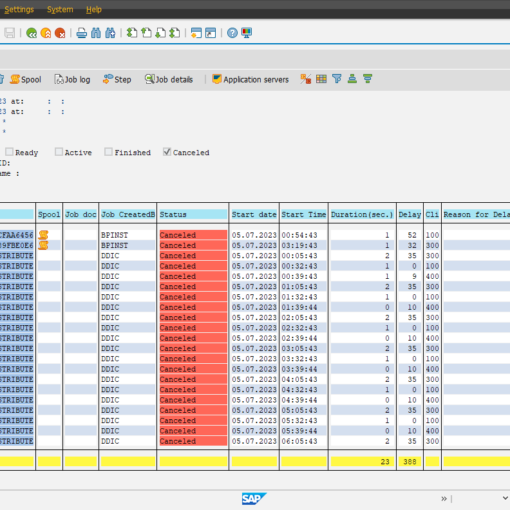What is SAP EWM?
SAP EWM is a component of SAP AG’s Supply Chain Management suite of solutions. The Extended Warehouse Management package is a software platform that provides rigid, automated support for processing goods movements and warehouse inventory management.
SAP EWM gives businesses the capacity to manage warehouse processes and movements, reduce difficulties and concerns with improved warehouse efficiency, and turn operations into a resource-sharing adaptive fulfillment supply chain. SAPewm is similar to SAP WM in terms of functionality, but it allows for more customization of objects such as warehouse structure, picking, putaway, HU (handling unit), RF, and more. Also included in SAP EWM are Activity Areas, Work Centers, and Resources, all of which are new features in SAP WM.
SAP Extended Warehouse Management (EWM) is used to efficiently manage inventories in the warehouse as well as to support goods movement procedures. It enables the organization to manage the inbound and outgoing procedures as well as the movement of goods in the warehouse. Incoming and exiting materials, goods reception and issue, client order fulfillment, and distribution of goods are the primary processes in a warehouse. There is no need for Warehouse management to manage items if a corporation does not store any goods.
The inbound process entails storing products in a warehouse and determining their location, whereas the outbound process is collecting up the commodities. When a material is stored in a warehouse, it is placed in a storage bin, where its current position may be found.
SAP EWM vs WM
Definition
- SAP EWM places a strong emphasis on logistics. This is a feature of SAP’s supply chain management system. A Business Package, on the other hand, is not included in the suite. It’s also possible to get it without the SCM. Standard warehouse management applications are included in the tool.
- SAP WM has evolved into a highly effective tool for managing database stocks, making modifications to the stock management system, and moving products from one location to another. The technology can also be used to introduce operational tasks to its warehouses more effectively.
Benefits
- The management of EWM focuses on operations such as locating bulk storage, racking facilities, and bin locations.
- Apart from allocating duties and monitoring warehouse orders, SAP EWM assists warehouse managers by integrating operations.
- Integrates the operations of slotting, cross-docking, kitting, VAS, yard management, de-consolidation, and sophisticated internal routing to utilize all available resources and maintain warehouse orders.
- SAP EWM keeps track of all warehouse activities, such as storage bins and handling units, as well as employing all available resources and keeping them at a healthy rate.
- SAP WM is capable of troubleshooting and dealing with complicated warehouse supplies in a more efficient and straightforward manner.
- With WMS’s pick-and-put away processes, the material flow becomes exceedingly seamless.
- SAP WM is responsible for concerns such as proper stock processing, effective administration of goods receipts, and stock transfers. For both enterprises and their consumers, the tool has made work processes far more progressive and transparent.
- SAP WMS aids businesses in overcoming the issues of warehouse inventory management in a methodical and cost-effective manner.
Flexibility
- In terms of warehouse and process design flexibility, SAP EWM provides a higher level of freedom.
- The architecture of processes and warehouses in SAP WMS is not very flexible.
Cons
- As a result of the SAP EWM interface with automation and field devices, it is slightly unsuitable for use.
- Configuring for best benefit necessitates skill; wrong processing for SAP WM results in more complicated issues.
SAP EWM Features
- You can manage warehouse tasks such as picking, mailing, and monitoring storage bins and good receipts.
- Before goods receipt from EWM to the ERP system, reversal or correction of the goods receipt from EWM to the ERP system, and an incoming delivery split from EWM to the ERP system, you can create an alert for altered data.
- It enables you to complete executable tasks such as work packages, which are collections of warehouse jobs that warehouse staff should complete as part of warehouse management activities.
- It also involves the storage, handling, and transportation of hazardous substances in compliance with SAP Environmental Health & Safety EHS laws.
- Warehouse cockpit is a feature in EWM that allows you to graphically display warehouse important figures and evaluate or monitor activities using specific chart types.
- From yard check-in to yard check-out, it allows you to manage and track vehicles and other transportation units, as well as movements and other tasks within the yard.
EWM Deployment options
SAP EWM can be considered as deployed in an ERP server or you can also consider it as an application in the Supply Chain Management landscape. SAP Extended Warehouse Management is coupled with ERP to access transaction and master data, and it also requires CRM integration to use features like slotting and availability check.
It is treated as a distinct application that runs on the same server as the SCM applications. SAP EWM can also be run in its own SCM environment, which is better for performance.
The following image shows the deployment options for SAP EWM.

- Figure 1 shows SAP EWM on SCM Server.
- Figure 2 shows SAP EWM as a Standalone
What is SAP EWM used for?
SAP EWM (Extended Warehouse Management) is a comprehensive solution designed to optimize and streamline warehouse operations. It provides advanced functionalities and tools that enable businesses to efficiently manage and control their inventory, enhance order fulfillment processes, and improve overall warehouse efficiency. Here are some key uses and benefits of SAP EWM:
- Inventory Management: SAP EWM offers real-time visibility into inventory levels, locations, and stock movements. It enables businesses to accurately track and manage inventory across multiple warehouses, ensuring optimal stock levels, reducing stockouts, and minimizing excess inventory.
- Warehouse Process Optimization: SAP EWM optimizes warehouse processes by providing tools for efficient goods receipt, putaway, picking, packing, and shipping operations. It supports various picking strategies, wave management, cross-docking, and value-added services, enabling businesses to streamline operations and improve order fulfillment speed and accuracy.
- Labor and Resource Management: SAP EWM helps in planning and optimizing labor resources within the warehouse. It provides tools for workforce management, task allocation, and workload balancing, allowing businesses to improve labor productivity, reduce errors, and better utilize resources.
- Warehouse Automation and Integration: SAP EWM seamlessly integrates with various warehouse automation technologies, such as conveyor systems, automated storage and retrieval systems (AS/RS), and robotics. It enables businesses to automate repetitive tasks, increase operational efficiency, and reduce manual handling errors.
- Yard Management: SAP EWM includes functionalities for managing yard operations, such as gate management, appointment scheduling, and dock management. It helps optimize inbound and outbound logistics processes, reduce waiting times, and improve overall yard efficiency.
- Analytics and Reporting: EWM provides robust analytics and reporting capabilities, offering insights into warehouse performance, inventory accuracy, order fulfillment rates, and other key metrics. This data-driven approach enables businesses to make informed decisions, identify areas for improvement, and drive continuous process optimization.
Overall, EWM empowers businesses to achieve efficient and effective warehouse operations, resulting in improved customer satisfaction, reduced costs, enhanced productivity, and better supply chain visibility. It serves as a critical tool for businesses looking to optimize their warehouse processes and stay competitive in today’s dynamic market.
Conclusion:
SAP Extended Warehouse Management (SAP EWM) is a powerful solution that revolutionizes warehouse operations, enabling businesses to optimize inventory management, streamline logistics processes, and enhance overall supply chain efficiency. With its advanced functionalities and seamless integration with other SAP modules, SAP EWM empowers organizations to achieve real-time visibility, improve order fulfillment, and drive operational excellence in their warehouses. By leveraging SAP EWM, businesses can gain a competitive edge in today’s dynamic market, ensuring faster, more accurate, and cost-effective warehouse operations.





